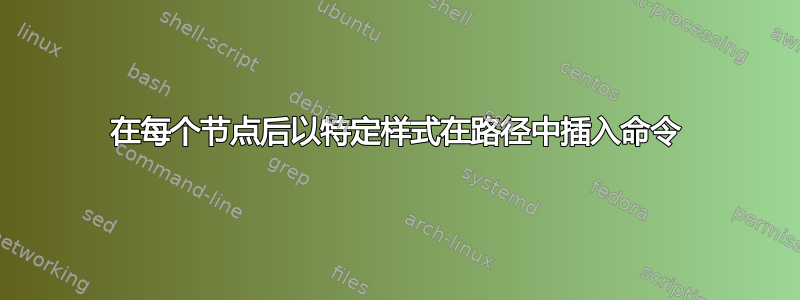
我想制作思维导图并将每片叶子与外部节点连接起来。我该怎么做?
在下面的例子中,我想连接每个
示例代码:
\tikzset{
top concept/.style = {mindmap, concept color=orange},
is6/.style = {concept},
to6/.style = {concept},
isConc/.style = {concept},
toConc/.style = {concept}
}
\begin{tikzpicture}
\node[circle,draw] (thatnode) at (10,0) {that other node};
\path[top concept] (0,20cm) node[isConc, insert path={circle[fill=red,radius=5cm]}] {Statistic} [clockwise from=0]
child[toConc] { node[isConc] {general theory}
child[to6] { node[is6] {intro to propability} }
child[to6] { node[is6] {asymptotics and Law of large number} }
child[to6] { node[is6] {asymptotics and Central Limit Theorem} }
}
child[toConc] { node[isConc] {distributions} [clockwise from=90]
child[to6] { node[is6] {binomial distrubtion} }
child[to6] { node[is6] {normal distribution} }
child[to6] { node[is6] {poisson distribution} }
}
child[toConc] { node[isConc] {statistics} [clockwise from=-30]
child[to6] { node[is6] {variability, variance} }
child[to6] { node[is6] {expected value} }
}
child[toConc] { node[isConc] {propability}
child[to6] { node[is6] {propability mass functions} }
child[to6] { node[is6] {propability density functions} }
child[to6] { node[is6] {baye's rule} }
child[to6] { node[is6] {independence} }
}
child[toConc] { node[isConc] {hypothesis testing}
child[to6] { node[is6] {standard error of mean} }
child[to6] { node[is6] {T confidence intervals} }
child[to6] { node[is6] {T tests} }
child[to6] { node[is6] {hypothesis testing} }
child[to6] { node[is6] {two group testing} }
child[to6] { node[is6] {pvalues} }
child[to6] { node[is6] {power} } % (propability of rejecting null hypothesis when false)
child[to6] { node[is6] {bootstrapping} }
child[to6] { node[is6] {permutation tests} }
}
;
\end{tikzpicture}
我想到了一些类似的事情:
\tikzset{
is6/.style = {concept, concept color=col6, alias=this, append after command={(this) -- (thatnode)}},
to6/.style = {concept, concept color=colI!50!col6},
}
小型工作示例:
我想融入(this) -- (othernode)这种风格。
\documentclass[a4paper,10pt]{article} \usepackage[utf8]{inputenc} \usepackage{tikz} \usetikzlibrary{shapes,arrows,chains,positioning,calc,trees,mindmap}
\tikzset{ is6/.style = {concept, concept color=green, text=black, alias=this}, to6/.style={concept}, isConc/.style={concept, color=orange, text=black}, toConc/.style={concept, text=black}}
\begin{document}
\begin{tikzpicture} \node[fill=red, circle] (othernode) at (7,7) {adsf}; \path[mindmap, concept, color=orange] (0,0cm) node[isConc] {Statistic} [clockwise from=90] child[toConc] { node[isConc] {general theory} child[to6] { node[is6] {intro} (this) -- (othernode) } child[to6] { node[is6] {outro} (this) -- (othernode) } } child[toConc] { node[isConc] {distributions} [clockwise from=0] child[to6] { node[is6] {binomial} (this) -- (othernode) } child[to6] { node[is6] {normal} (this) -- (othernode) } } ;
\end{tikzpicture}
\end{document}
顺便提一句。Tikz \draw 作为样式的一部分(在某些类型的每个节点内绘制某些内容)不一样 ;-)。
答案1
如果othernode在绘制思维导图之前定义了,那么可以使用\pgfextra里面的命令style来绘制思维导图节点和其他节点之间的链接。
\documentclass[a4paper,10pt]{article}
\usepackage[utf8]{inputenc}
\usepackage{tikz}
\usetikzlibrary{shapes,arrows,chains,positioning,calc,trees,mindmap}
\tikzset{
is6/.style = {concept, concept color=green,
text=black, alias=this,
append after command={
\pgfextra{
\draw[red,dashed] (this)--(othernode);}
}},
to6/.style={concept},
isConc/.style={concept, color=orange, text=black},
toConc/.style={concept, text=black}}
\begin{document}
\begin{tikzpicture}
\node[fill=red, circle] (othernode) at (7,7) {adsf};
\path[mindmap, concept, color=orange] (0,0cm)
node[isConc] {Statistic} [clockwise from=90]
child[toConc]{node[isConc] {general theory}
child[to6] {node[is6] {intro}}
child[to6] {node[is6] {outro}}}
child[toConc] {node[isConc] {distributions} [clockwise from=0]
child[to6] {node[is6] {binomial}}
child[to6] {node[is6] {normal}}
};
\end{tikzpicture}
\end{document}



